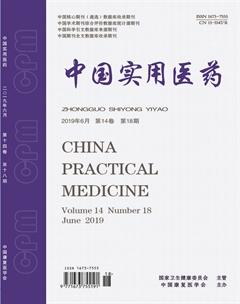福州市單中心腹膜透析患者終止治療危險因素分析
王芳 黃麗麗 陳宇清 黃麗釵



【摘要】 目的 分析福州市單中心持續非臥床腹膜透析(CAPD)患者終止治療的危險因素, 為透析方式的選擇提供參考, 從而早期采取措施降低終止率。方法 212例行CAPD治療患者, 均實施腹膜透析管植入術, 研究終點為術后行CAPD治療3年, 到研究終點仍行 CAPD治療的患者為維持CAPD組, 3年內終止CAPD治療患者為終止CAPD組, 終止CAPD組根據轉歸分為死亡組和轉血液透析組。比較三組患者性別、年齡、文化程度、原發病、術前實驗室指標水平, 分析患者死亡原因、轉血液透析原因。結果 212例患者中, 終止CAPD治療47例, 占22.17%, 其中33例死亡, 占終止治療的70.21%;
14例轉血液透析, 占終止治療的29.79%。死亡組患者年齡為(63.85±6.16)歲, 明顯高于維持 CAPD組的(52.42±7.59)歲, 差異具有統計學意義(t=8.127, P<0.05);轉血液透析組患者初中及以下文化程度所占比例為85.71%, 明顯高于維持CAPD組的56.36%, 差異具有統計學意義(χ2=4.584, P<0.05)。死亡組患者糖尿病腎病所占比例為36.36%, 明顯高于維持CAPD組的16.36%, 差異具有統計學意義(χ2=6.950, P<0.05)。轉血液透析組患者術前血肌酐水平為(967.95±39.07)μmol/L, 明顯高于維持 CAPD組的(933.27±58.73)μmol/L, 差異具有統計學意義(t=2.166, P<0.05);死亡組、轉血液透析組患者術前血紅蛋白水平分別為(76.66±7.15)、(73.53±7.21)g/L, 明顯低于維持 CAPD組的(81.86±6.22)g/L, 差異具有統計學意義(t=-4.273、-4.751, P<0.05)。CAPD患者死亡的第一位原因為腦血管疾病, 占39.39%;第二位原因為心血管疾病, 占21.21%。CAPD患者轉血液透析的第一位原因為腹膜炎, 占50.00%。結論 CAPD
患者終止治療的第一位原因是死亡, 第二位是轉血液透析;導致死亡的危險因素有高齡、原發病糖尿病腎病、術前血紅蛋白低、并發心腦血管疾病, 轉血液透析的危險因素有文化程度低、術前血肌酐高及血紅蛋白低、并發腹膜炎。
【關鍵詞】 腹膜透析;終止;危險因素;分析
DOI:10.14163/j.cnki.11-5547/r.2019.18.006
Analysis of risk factors for termination treatment in patients with single-center peritoneal dialysis in Fuzhou? ?WANG Fang, HUANG Li-li, CHEN Yu-qing, et al. Second Peoples Hospital Affiliated to Fujian University of Traditional Chinese Medicine, Fuzhou 350001, China
【Abstract】 Objective? ?To analyze the risk factors of termination treatment in continuous ambulatory peritoneal dialysis (CAPD) patients in Fuzhou single center, so as to provide reference for the selection of dialysis methods, and take early measures to reduce the termination rate. Methods? ?A total of 212 patients were treated with CAPD, and peritoneal dialysis tube implantation was performed. The study ended at 3 years after CAPD treatment. Patients still treated with CAPD at the end of the study were taken as maintained CAPD group, and patients terminated CAPD treatment within 3 years were taken as terminated CAPD group. Terminated CAPD group were divided by outcome into death group and hemodialysis group. The gender, age, education level, primary disease and preoperative laboratory index levels of the three groups were compared, and the causes of death and hemodialysis were analyzed. Results? ?Of the 212 patients, 47 cases discontinued CAPD, accounting for 22.17%, of which 33 cases died, accounting for 70.21% of termination treatment cases, and 14 cases underwent hemodialysis, accounting for 29.79% of termination treatment cases. Death group had obviously higher age as (63.85±
6.16) years old than (52.42±7.59) years old in maintained CAPD group, and the difference was statistically significant (t=8.127, P<0.05). Hemodialysis group had obviously higher proportion of junior high school and below as 85.71% than 56.36% in maintained CAPD group, and the difference was statistically significant (χ2=4.584, P<0.05). Death group had obviously higher proportion of diabetic nephropathy as 36.36% than 16.36% in maintained CAPD group, and the difference was statistically significant (χ2=6.950, P<0.05). Hemodialysis group had obviously higher preoperative serum creatinine level as (967.95±39.07) μmol/L than (933.27±58.73) μmol/L
in maintained CAPD group, and the difference was statistically significant (t=2.166, P<0.05). Death group and hemodialysis group had obviously lower preoperative hemoglobin level as (76.66±7.15) and (73.53±7.21) g/L
than (81.86±6.22) g/L in maintained CAPD group, and the difference was statistically significant (t=-4.273, -4.751, P<0.05). The leading cause of death in CAPD patients was cerebrovascular disease, accounting for 39.39%, followed by cardiovascular disease, accounting for 21.21%. Peritonitis was the first cause of hemodialysis in CAPD patients, accounting for 50.00%. Conclusion? ?The leading cause of termination treatment for CAPD patients is death, followed by hemodialysis. The risk factors leading to death are old age, primary diabetic nephropathy, low preoperative hemoglobin and cardio-cerebrovascular diseases. The risk factors of hemodialysis are low education level, high preoperative creatinine and low preoperative hemoglobin, and complicated with peritonitis.
【Key words】 Peritoneal dialysis; Termination; Risk factors; Analysis
近年來, 全球范圍內慢性腎臟病(CKD)患者不斷增長, CKD發展為終末期腎病(ESRD)數量逐年增多[1, 2]。這種情況是公共衛生問題之一, 而且引起全世界關注[3]。ESRD重要的腎臟替代治療方法是CAPD, 并且操作簡便, 血流動力學穩定, 能有效保護殘余腎功能[4]。但由于各種原因, 部分患者終止了CAPD治療。本研究統計分析福州市單腹膜透析中心CAPD治療患者的資料, 探討終止治療的危險因素, 以期為臨床提供參考。現報告如下。
1 資料與方法
1. 1 一般資料 選取2012年1月~2017年12月于福州市單個腹膜透析中心進行 CAPD治療的212例患者為研究對象。納入標準:①實施腹膜透析管植入術時間為2012年1月~2014年12月;②術后行CAPD治療;③腹膜透析資料完整。排除標準:①轉腎移植患者;②失訪患者。
1. 2 研究方法 研究終點為術后行CAPD治療3年, 到研究終點仍行 CAPD治療的患者為維持CAPD組, 3年內終止CAPD治療患者為終止CAPD組, 終止CAPD組根據轉歸分為死亡組和轉血液透析組。記錄三組患者性別、年齡、文化程度、原發病、術前實驗室指標(血肌酐、血尿素氮、血白蛋白、血紅蛋白)水平, 分析患者死亡原因、轉血液透析原因。
1. 3 統計學方法 采用SPSS21.0統計學軟件對研究數據進行統計分析。計量資料以均數±標準差( x-±s)表示, 采用t檢驗;計數資料以率(%)表示, 采用χ2檢驗。P<0.05表示差異具有統計學意義。
2 結果
2. 1 患者終止CAPD轉歸分析 212例患者中, 終止CAPD治療47例, 占22.17%, 其中33例死亡, 占終止治療的70.21%;14例轉血液透析, 占終止治療的29.79%。

